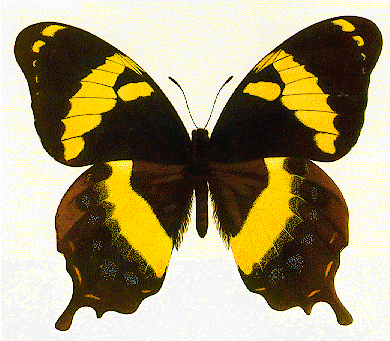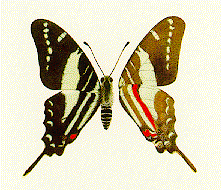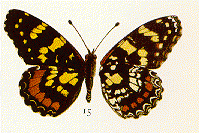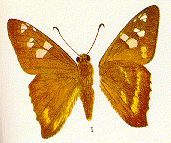Butterflies and Lepidopterists
There are over 133 species and subspecies of butterflies in Jamaica, 31 of which are endemic. The most famous is the Papilio homerus, the biggest swallow-tail butterfly in the world.
The butterfly is found at the lower elevations of the Blue Mountains especially in St Thomas and Portland, in the Cockpit country of Trelawny and St Elizabeth. It was first noted in Jamaica in 1793. You can read more about "Papilio Homerus",in an article by D.J.R. Walker, in Natural History Notes of the Natural History Society of Jamaica, nos 22,23 (combined), p.164.
Another species which is also found in Jamaica is
Papilio homerus, the biggest swallow-tail butterfly in the world.
The butterfly is found at the lower elevations of the Blue Mountains especially in St Thomas and Portland, in the Cockpit country of Trelawny and St Elizabeth. It was first noted in Jamaica in 1793. You can read more about "Papilio Homerus",in an article by D.J.R. Walker, in Natural History Notes of the Natural History Society of Jamaica, nos 22,23 (combined), p.164.
Another species which is also found in Jamaica is  Graphium marcellinus Also known as the Jamaican Kite Swallowtail, this butterfly was first observed by lepidopterists in 1725 but only catalogued in 1845. The species has been observed most often in St Andrew, but it appears sporadically within weeks.
Graphium marcellinus Also known as the Jamaican Kite Swallowtail, this butterfly was first observed by lepidopterists in 1725 but only catalogued in 1845. The species has been observed most often in St Andrew, but it appears sporadically within weeks.
Source: Brown FM, Heineman B. Jamaica and its Butterflies. London: E W. Classey Ltd. 1972. 478 pp ISBN 0 900848 448
There have been some native born Lepidopterists and two have had butterflies named for them.
The first is E Stuart Panton for whom the butterfly  Atlantea pantoni was named. He was born in Jamaica in 1866 and lived until his death in 1962 at "Hopeton" near Mandeville. He was educated in England and raised livestock on his property. He had a wide interest in natural history and was a member of the staff of the Institute of Jamaica.
The second is Miss Lily Perkins who discovered two butterflies new to science. Miss Perkins lived at Lumsden, St Ann but it was during the time her father was working in Trelawny and rented Baron Hill house near Jackson Town when she discovered
Atlantea pantoni was named. He was born in Jamaica in 1866 and lived until his death in 1962 at "Hopeton" near Mandeville. He was educated in England and raised livestock on his property. He had a wide interest in natural history and was a member of the staff of the Institute of Jamaica.
The second is Miss Lily Perkins who discovered two butterflies new to science. Miss Perkins lived at Lumsden, St Ann but it was during the time her father was working in Trelawny and rented Baron Hill house near Jackson Town when she discovered  Leptotes perkinsae also known as Miss Perkin's Blue. This butterfly was first identified in 1931 and is partial to the flowers of the Bull Hoof (Bauhinia divaricata). It is found all over Jamaica. At Lumsden she collected a new species called Phocides lincea perkinsi
Leptotes perkinsae also known as Miss Perkin's Blue. This butterfly was first identified in 1931 and is partial to the flowers of the Bull Hoof (Bauhinia divaricata). It is found all over Jamaica. At Lumsden she collected a new species called Phocides lincea perkinsi also named Miss Perkin's Skipper. It is found in St James, Trelawny and St Ann.
also named Miss Perkin's Skipper. It is found in St James, Trelawny and St Ann.
On a personal note, Miss Perkins used to teach my sister art in 1951 at St Hilda's High School driving in to Brown's Town from the Bamboo area. Her art was on exhibit in the Institute of Jamaica the same year as my grandfather H.Q. Levy's She died after 1971.











 Papilio homerus, the biggest swallow-tail butterfly in the world.
The butterfly is found at the lower elevations of the Blue Mountains especially in St Thomas and Portland, in the Cockpit country of Trelawny and St Elizabeth. It was first noted in Jamaica in 1793. You can read more about "Papilio Homerus",in an article by D.J.R. Walker, in Natural History Notes of the Natural History Society of Jamaica, nos 22,23 (combined), p.164.
Another species which is also found in Jamaica is
Papilio homerus, the biggest swallow-tail butterfly in the world.
The butterfly is found at the lower elevations of the Blue Mountains especially in St Thomas and Portland, in the Cockpit country of Trelawny and St Elizabeth. It was first noted in Jamaica in 1793. You can read more about "Papilio Homerus",in an article by D.J.R. Walker, in Natural History Notes of the Natural History Society of Jamaica, nos 22,23 (combined), p.164.
Another species which is also found in Jamaica is  Graphium marcellinus Also known as the Jamaican Kite Swallowtail, this butterfly was first observed by lepidopterists in 1725 but only catalogued in 1845. The species has been observed most often in St Andrew, but it appears sporadically within weeks.
Graphium marcellinus Also known as the Jamaican Kite Swallowtail, this butterfly was first observed by lepidopterists in 1725 but only catalogued in 1845. The species has been observed most often in St Andrew, but it appears sporadically within weeks.
 Atlantea pantoni was named. He was born in Jamaica in 1866 and lived until his death in 1962 at "Hopeton" near Mandeville. He was educated in England and raised livestock on his property. He had a wide interest in natural history and was a member of the staff of the Institute of Jamaica.
The second is Miss Lily Perkins who discovered two butterflies new to science. Miss Perkins lived at Lumsden, St Ann but it was during the time her father was working in Trelawny and rented Baron Hill house near Jackson Town when she discovered
Atlantea pantoni was named. He was born in Jamaica in 1866 and lived until his death in 1962 at "Hopeton" near Mandeville. He was educated in England and raised livestock on his property. He had a wide interest in natural history and was a member of the staff of the Institute of Jamaica.
The second is Miss Lily Perkins who discovered two butterflies new to science. Miss Perkins lived at Lumsden, St Ann but it was during the time her father was working in Trelawny and rented Baron Hill house near Jackson Town when she discovered  Leptotes perkinsae also known as Miss Perkin's Blue. This butterfly was first identified in 1931 and is partial to the flowers of the Bull Hoof (Bauhinia divaricata). It is found all over Jamaica. At Lumsden she collected a new species called Phocides lincea perkinsi
Leptotes perkinsae also known as Miss Perkin's Blue. This butterfly was first identified in 1931 and is partial to the flowers of the Bull Hoof (Bauhinia divaricata). It is found all over Jamaica. At Lumsden she collected a new species called Phocides lincea perkinsi also named Miss Perkin's Skipper. It is found in St James, Trelawny and St Ann.
also named Miss Perkin's Skipper. It is found in St James, Trelawny and St Ann.